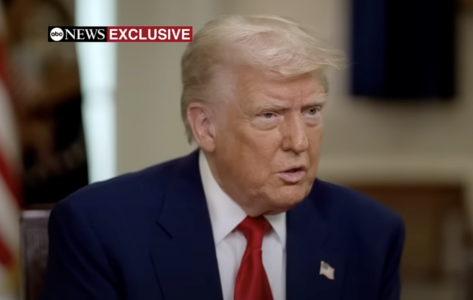Think Trump’s tariffs mean lower taxes for you? What you need to know, according to experts
- Replies 1
If you’ve been following the headlines lately, you may have heard former President Donald Trump touting a bold new promise: that his sweeping tariffs on imported goods could lead to lower—or even eliminated—income taxes for most Americans.
It’s a claim that’s caught the attention of many, especially those of us on fixed incomes or looking for ways to stretch our retirement dollars a little further. B
But is there any truth to it? Can tariffs really replace the income taxes we pay each year? Here are the details, opinions of tax experts, and numbers—no political spin, just the facts.
The promise: Lower income taxes
Former President Donald Trump has framed his administration’s new and expansive tariffs not just as a way to boost US manufacturing, but also as a step toward slashing—or even entirely eliminating—income taxes for many Americans.
“When tariffs cut in, many people’s income taxes will be substantially reduced, maybe even completely eliminated. Focus will be on people making less than $200,000 a year,” Trump wrote Sunday on Truth Social, his social media platform.
The tariff hikes have already taken effect, with some businesses now facing import duties as high as 145% on Chinese goods and 10% on items from nearly every other country.
These costs, often passed down to consumers, are expected to increase prices and feed inflation, which many Americans are already preparing for.

Trump has previously claimed that elevated tariffs could generate over $1 trillion in federal revenue within the next year.
Speaking before boarding Air Force One after attending Pope Francis’ funeral, he reiterated that the money raised “will be enough to cut all of the income tax” in the US.
The White House has not commented on whether any formal plan is being drafted to cut income taxes for most Americans.
Are tariffs linked to tax cuts?
No current bill in Congress—which holds the power to change the tax code—proposes eliminating federal income taxes for those earning under $200,000.
Also read: Tariff plan paused—Trump steps back after market chaos shakes investors
However, lawmakers are considering a reconciliation bill that would extend Trump’s 2017 tax cuts and add a few new provisions from his campaign, such as removing taxes on employee tips.
Even if passed, this legislation would largely preserve the current tax brackets, which range from 10% to 37% depending on income, meaning most Americans wouldn’t see a reduction in their tax rate.
“There is no real connection” between the proposed tariffs and income tax cuts, said Erica York, vice president of federal tax policy at the Tax Foundation. “He has the authority to impose higher tariffs, and he’s done that. But he doesn’t have the authority to unilaterally cut income taxes—that’s done by Congress.”
According to York, there is “zero chance” Congress would agree to eliminate income taxes for a wide segment of Americans because the tariff revenue wouldn’t come close to replacing the $2.4 trillion brought in annually from income taxes.
Source: The Wall Street Journal / Youtube.
Even if the US doubled current tariff rates to 50% on all imports, that would still generate less than 40% of existing income tax revenue, the Peterson Institute for International Economics estimates.
The reality: Tariffs can’t replace income taxes
York further explained that Trump's tariffs may raise around $170 billion this year—far short of the $700 billion needed to offset taxes on those earning under $200,000.
“You would need tariffs multiple times higher than what we have now” to fill that gap, York said. “Making the math work is an impossibility.”
Increasing tariffs even further would also increase the risk of an economic downturn, triggering job losses, reduced consumer spending, and weakened business investment—all of which could further reduce government revenue.
Also read: From tariffs to the courtroom: 12 states challenge sweeping trade policy under Trump
Trump’s claim amounts to “an argument that says, ‘If Americans pay more out of their left pocket, the government will be able to put more in their right pocket,’” said Joe Rosenberg, a senior fellow at the Urban-Brookings Tax Policy Center.
“Even if you make the math work, it’s really replacing one form of tax with another—and the other important point here is these taxes have very different distributional effects across income types,” Rosenberg added.
In practice, tariffs tend to hit low- and middle-income Americans hardest, since they spend a larger share of their income on essentials like groceries and household items.
Under Trump’s proposed tariffs, a typical low-income family could see a 5.5% reduction in disposable income, while the wealthiest households would lose only about 1.9%, according to the Yale Budget Lab.
Source: CBS News / Youtube.
Faced with rising prices, consumers are likely to reduce spending, which economists say makes it even harder to rely on tariffs to replace income tax revenue.
Conflicting policy goals
Experts told CBS MoneyWatch that Trump’s push to raise tariffs to levels not seen since 1943 reveals conflicting objectives.
While he claims tariffs will help secure stronger trade deals, reducing or eliminating tariffs in future agreements would directly undermine the idea of using them as a long-term revenue source.
Scott Lincicome, a trade analyst at the Cato Institute, noted that Trump’s inconsistent approach—such as creating exemptions and temporarily suspending some tariffs—further complicates revenue projections.
Also read: Could tariffs boost or shrink your Social Security COLA?
“If you are tariffs on, tariffs off, because of these negotiations that are supposedly going on, you’re not raising much revenue, or protecting industry or getting new investment in the United States because of all the uncertainty,” Lincicome said.
By promoting tax cuts in connection with his tariff plan, Trump may be trying to sell Americans on the idea that short-term pain will yield long-term gain. But experts argue the costs may be too steep.
“Americans are about to find out really fast that this is a tax on us,” York said. “It will hurt our trading partners, too, but it is a tax that in large part falls on American businesses and American workers.”
Read next: “It’s coming”: Wall Street titan sounds alarm on economic outlook

Have you noticed higher prices at the store? Do you think tariffs are a good way to raise government revenue? Have you ever benefited from a tax cut? Share your thoughts and experiences in the comments below!
It’s a claim that’s caught the attention of many, especially those of us on fixed incomes or looking for ways to stretch our retirement dollars a little further. B
But is there any truth to it? Can tariffs really replace the income taxes we pay each year? Here are the details, opinions of tax experts, and numbers—no political spin, just the facts.
The promise: Lower income taxes
Former President Donald Trump has framed his administration’s new and expansive tariffs not just as a way to boost US manufacturing, but also as a step toward slashing—or even entirely eliminating—income taxes for many Americans.
“When tariffs cut in, many people’s income taxes will be substantially reduced, maybe even completely eliminated. Focus will be on people making less than $200,000 a year,” Trump wrote Sunday on Truth Social, his social media platform.
The tariff hikes have already taken effect, with some businesses now facing import duties as high as 145% on Chinese goods and 10% on items from nearly every other country.
These costs, often passed down to consumers, are expected to increase prices and feed inflation, which many Americans are already preparing for.

Donald Trump has claimed that increased tariffs could lead to lower, or even eliminated, income taxes for most Americans, especially those earning under $200,000, but tax experts say there is no real link between tariffs and lower income taxes. Image source: ABC7 / Youtube.
Trump has previously claimed that elevated tariffs could generate over $1 trillion in federal revenue within the next year.
Speaking before boarding Air Force One after attending Pope Francis’ funeral, he reiterated that the money raised “will be enough to cut all of the income tax” in the US.
The White House has not commented on whether any formal plan is being drafted to cut income taxes for most Americans.
Are tariffs linked to tax cuts?
No current bill in Congress—which holds the power to change the tax code—proposes eliminating federal income taxes for those earning under $200,000.
Also read: Tariff plan paused—Trump steps back after market chaos shakes investors
However, lawmakers are considering a reconciliation bill that would extend Trump’s 2017 tax cuts and add a few new provisions from his campaign, such as removing taxes on employee tips.
Even if passed, this legislation would largely preserve the current tax brackets, which range from 10% to 37% depending on income, meaning most Americans wouldn’t see a reduction in their tax rate.
“There is no real connection” between the proposed tariffs and income tax cuts, said Erica York, vice president of federal tax policy at the Tax Foundation. “He has the authority to impose higher tariffs, and he’s done that. But he doesn’t have the authority to unilaterally cut income taxes—that’s done by Congress.”
According to York, there is “zero chance” Congress would agree to eliminate income taxes for a wide segment of Americans because the tariff revenue wouldn’t come close to replacing the $2.4 trillion brought in annually from income taxes.
Source: The Wall Street Journal / Youtube.
Even if the US doubled current tariff rates to 50% on all imports, that would still generate less than 40% of existing income tax revenue, the Peterson Institute for International Economics estimates.
The reality: Tariffs can’t replace income taxes
York further explained that Trump's tariffs may raise around $170 billion this year—far short of the $700 billion needed to offset taxes on those earning under $200,000.
“You would need tariffs multiple times higher than what we have now” to fill that gap, York said. “Making the math work is an impossibility.”
Increasing tariffs even further would also increase the risk of an economic downturn, triggering job losses, reduced consumer spending, and weakened business investment—all of which could further reduce government revenue.
Also read: From tariffs to the courtroom: 12 states challenge sweeping trade policy under Trump
Trump’s claim amounts to “an argument that says, ‘If Americans pay more out of their left pocket, the government will be able to put more in their right pocket,’” said Joe Rosenberg, a senior fellow at the Urban-Brookings Tax Policy Center.
“Even if you make the math work, it’s really replacing one form of tax with another—and the other important point here is these taxes have very different distributional effects across income types,” Rosenberg added.
In practice, tariffs tend to hit low- and middle-income Americans hardest, since they spend a larger share of their income on essentials like groceries and household items.
Under Trump’s proposed tariffs, a typical low-income family could see a 5.5% reduction in disposable income, while the wealthiest households would lose only about 1.9%, according to the Yale Budget Lab.
Source: CBS News / Youtube.
Faced with rising prices, consumers are likely to reduce spending, which economists say makes it even harder to rely on tariffs to replace income tax revenue.
Conflicting policy goals
Experts told CBS MoneyWatch that Trump’s push to raise tariffs to levels not seen since 1943 reveals conflicting objectives.
While he claims tariffs will help secure stronger trade deals, reducing or eliminating tariffs in future agreements would directly undermine the idea of using them as a long-term revenue source.
Scott Lincicome, a trade analyst at the Cato Institute, noted that Trump’s inconsistent approach—such as creating exemptions and temporarily suspending some tariffs—further complicates revenue projections.
Also read: Could tariffs boost or shrink your Social Security COLA?
“If you are tariffs on, tariffs off, because of these negotiations that are supposedly going on, you’re not raising much revenue, or protecting industry or getting new investment in the United States because of all the uncertainty,” Lincicome said.
By promoting tax cuts in connection with his tariff plan, Trump may be trying to sell Americans on the idea that short-term pain will yield long-term gain. But experts argue the costs may be too steep.
“Americans are about to find out really fast that this is a tax on us,” York said. “It will hurt our trading partners, too, but it is a tax that in large part falls on American businesses and American workers.”
Read next: “It’s coming”: Wall Street titan sounds alarm on economic outlook
Key Takeaways
- Donald Trump has claimed that increased tariffs could lead to lower, or even eliminated, income taxes for most Americans, especially those earning under $200,000, but tax experts say there is no real link between tariffs and lower income taxes.
- There is currently no bill in Congress that would remove federal income taxes for people earning under $200,000, and experts say the extra revenue from tariffs would not be nearly enough to replace the government’s income tax revenue.
- Replacing income tax with tariffs is considered “mathematically impossible” by experts, as tariffs would raise only a fraction of the revenue that income taxes generate, and raising tariffs much higher would risk recession and negatively affect consumers and the economy.
- Economists highlight that tariffs behave like a regressive tax, hitting lower- and middle-income households harder due to higher prices on goods, and ultimately most of the burden of tariffs would fall on American consumers and businesses, not foreign countries.
Have you noticed higher prices at the store? Do you think tariffs are a good way to raise government revenue? Have you ever benefited from a tax cut? Share your thoughts and experiences in the comments below!






